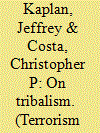| Srl | Item |
| 1 |
ID:
132360


|
|
|
|
|
| Publication |
2014.
|
| Summary/Abstract |
In this article, we endeavor to shed new light on the consequences of tribalism in the present day, one of the most important of which is the threat posed by lone wolf actors and the emergence of autonomous cells that operate with no central direction. To better acquaint the reader with the theoretical models used in this article-in particular the Trinitarian model of Carl von Clausewitz-we begin with historic models dating back to Alexander the Great. The central focus of our article posits a reconceptualization of tribalism as a driving force behind the global jihadist phenomenon. We will go into the cases of Iraq and Afghanistan in some depth, believing that it is necessary to provide a close examination of these case studies to better understand the emergence of jihadist lone wolves who operate both in the ungoverned spaces of the Middle East and South Asia and in their Western homelands. We conclude with an examination of cases of jihadist lone wolf terrorism involving recent converts to radical Islam in the U.S. Finally, our article focuses on the emerging security threats posed by lone wolves, autonomous cells, and the challenges ahead for the military, security, and intelligence services.
|
|
|
|
|
|
|
|
|
|
|
|
|
|
|
|
| 2 |
ID:
132363


|
|
|
|
|
| Publication |
2014.
|
| Summary/Abstract |
Research has shown that there is no profile of individual characteristics of group-based terrorists, but profiling the characteristics of lone wolf terrorists may yet be possible. In this article, we bring together suggestions about what a lone wolf profile might look like. We describe a two-pyramids model that distinguishes radicalization of opinion from radicalization of action, then use this model to review three case histories of lone wolf terrorists. We also review results comparing two kinds of mostly lone actor violent offenders: assassins and school attackers. Results highlight the gap between radical opinion and radical action, and suggest two profiles of lone wolf terrorists: disconnected-disordered are individuals with a grievance and weapons experience who are social loners and often show signs of psychological disorder; caring-compelled are individuals who strongly feel the suffering of others and feel a personal responsibility to reduce or avenge this suffering.
|
|
|
|
|
|
|
|
|
|
|
|
|
|
|
|